~ The website of local historian Maureen Newton ~
~ The website of local historian Maureen Newton ~ |
|
|

|
HUCKNALL MARKET PLACE The Early Years
What evidence is there for a Market Place or Village Green in Hucknall? In Beardsmoreís History of Hucknall
Torkard there is a drawing but it is a conjectural imagined picture of what the area might have looked like in the
Middle Ages.
Documentary material begins with an early photograph of 1860 and a drawing of the church in 1866 by Miss Otter which shows buildings in the background on what was to become the Market Place. On 11th August 1873, there was a meeting of the Local Board, (forerunner of the local council), when representatives of principal tradesmen and manufacturers asked what could be done to establish a public market. The Board requested a survey of the site and it was found that the wide road called Church Square, leading to the parish church, was in fact a continuation of Town Street (now known as High Street). On either side were shops and houses with roads branching off on the left. 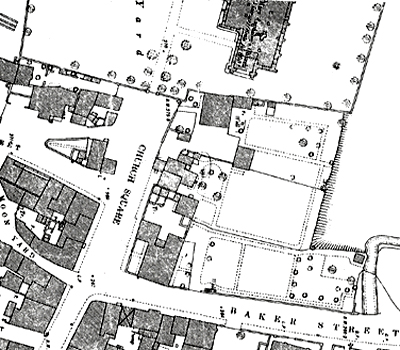
Tradesmen and vendors had been selling wares and working in Church Square for some time, as a bye-law was passed to stop them being there for more than six days in total. Then a date, April 23rd 1875, was set for an exciting event. Advertising and printed handbills told the population that on that Friday, (and succeeding Fridays), there was to be a market in Church Square. Soon though, the Market Committee were urging that steps should be taken to secure a larger site and recommended the ground on the right of Church Square, extending to the brook, or a property on Portland Road, but the Duke of Portlandís agent suggested a site on Beardall Street. This idea was deemed unacceptable by the Local Board. 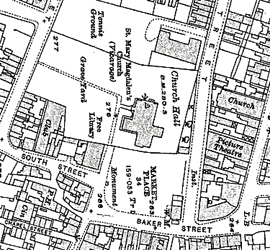
Matters seemed to stand there for a while, as the 1880 ordnance survey map above still shows just a wider roadway called Church Square, with buildings each side. This road to the church was said to be so narrow that it was impossible for carriages to turn round or pass one another. By 1886, buildings were being demolished to make a larger space, and in September 1889, advertisements said the market was to be re-opened. By comparison, the 1916 ordnance survey map is shown opposite. 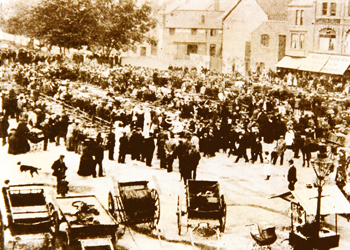 Then in 1904, a deputation of farmers, butchers and others proposed the opening of a cattle market.
This was formally opened on Tuesday 7th June. Advertisements had been put in various newspapers around the
area to attract a good crowd. Local butchers were there in force but buyers also came from Nottingham, Mansfield,
Kimberley, Woodborough, Bulwell, Kirkby and Epperstone. That day, 31beasts, 81 sheep, 116 pigs and 10
horses were sold, so it must have been a fantastic sight. One fine shorthorn bull, which weighed over a ton,
was sent by Mr. H. Rhodes of Whyburn. It was said that this farmer and others locally had a great reputation for
producing fine animals. Local butchers had bought superb stock and were expected to have some good beef.
Then in 1904, a deputation of farmers, butchers and others proposed the opening of a cattle market.
This was formally opened on Tuesday 7th June. Advertisements had been put in various newspapers around the
area to attract a good crowd. Local butchers were there in force but buyers also came from Nottingham, Mansfield,
Kimberley, Woodborough, Bulwell, Kirkby and Epperstone. That day, 31beasts, 81 sheep, 116 pigs and 10
horses were sold, so it must have been a fantastic sight. One fine shorthorn bull, which weighed over a ton,
was sent by Mr. H. Rhodes of Whyburn. It was said that this farmer and others locally had a great reputation for
producing fine animals. Local butchers had bought superb stock and were expected to have some good beef.
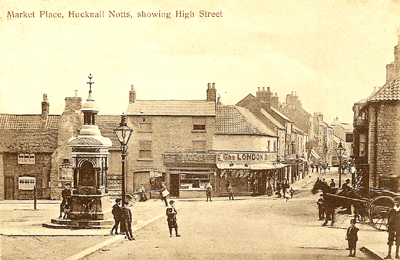
It was, however, regrettable that this didnít last. In September that year, it was reported that the cattle market had only 11 beasts and 20 sheep plus swine offered for sale, and by January 1905, it seemed as if the cattle market idea had run its course. It was necessary to decide what to do with the paraphernalia, and the railings and ring were no ornament to the Market Place. Opposite: Hucknall Market Place 1906. 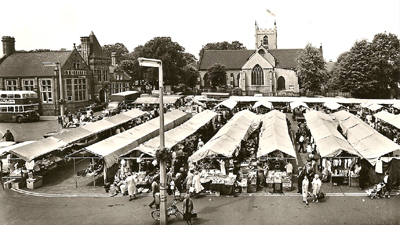
The space of the Market Place then, 100 years ago, was more or less as we know it today, but how different it might have been. How would you feel about Hucknall Market Place being on Portland Road or on Beardall Street instead of in the town centre where it is now? Opposite: Hucknall Market Place 1970. |

|
 |